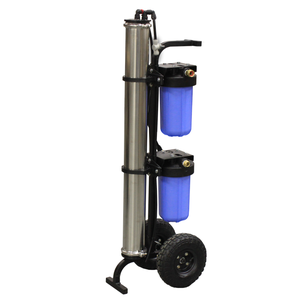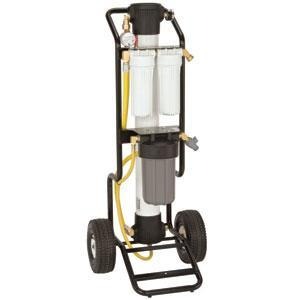3 stage vs 4 Stage, Carbon Filter and RO membrane life
Understanding the Differences: 3-Stage vs. 4-Stage Mobile RODI Carts
Reverse Osmosis Deionization (RODI) systems are pivotal in the water purification process, especially for applications requiring high purity water, such as window cleaning, aquarium maintenance, and various industrial processes. A crucial decision when selecting an RODI system is choosing between a 3-stage and a 4-stage mobile cart. This choice can significantly impact the system's efficiency, longevity, and overall performance based on your specific needs.
Considerations for Choosing an RODI System
Before diving into the specifics of 3-stage and 4-stage systems, it's essential to consider your expected use. Frequency of use (occasional vs. daily) and the volume of water needed will influence the ideal size of the carbon filter. For example, a small 2.5in by 10in carbon filter may require replacement every 4 to 5 weeks under daily use, while a larger 4.5in by 20in filter could last over six months.

Typical 3 Stage Filtration
1 Carbon/Sediment Filter
1 RO Membrane
1 DI Resin Filer

Typical 4 Stage Filtration
1 Sediment Filter
1 Carbon
1 RO Membrane
1 DI Resin Filer
The 3-Stage RODI System
A typical 3-stage system combines sediment and carbon filtration into one unit and is followed by the RO membrane and a DI resin filter. This setup is streamlined but effective, particularly where water quality is relatively controlled and predictable, such as with city water.
The 4-Stage RODI System
In contrast, a 4-stage system adds a separate sediment filter ahead of the carbon filter. This added layer is beneficial in scenarios where water quality is variable or contains higher levels of sediment, such as well water.
When evaluating an RODI system ... Consider:
The Impact of Filter Size Larger filters can add weight to a mobile cart, which might be a consideration for portability.
However, the longevity of your RO membrane, a more costly component, heavily depends on the effectiveness and condition of your preceding carbon filters. Proper maintenance and timely replacement of carbon filters are crucial to prevent chlorine from city-treated water from degrading the RO membrane, which, with proper care, can last 7 to 10 years.

